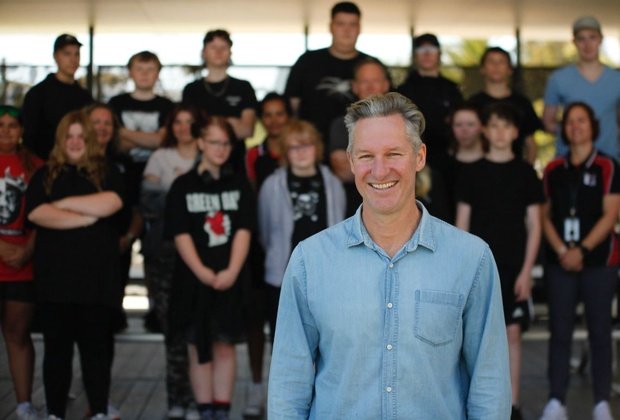The WA educator leads an intensive ‘middle school initiative’ at Port School, which sees at-risk and struggling Year 8 and 9 students enveloped in a primary school model of education – one that leaves absolutely nothing to chance.
“Ultimately, we operate each of those classrooms like a really high functioning Year 6 (classroom), so high-impact instruction for every core class,” Hopkins tells EducationHQ.
“We have very high expectations of behaviour, attendance and participation – they’re the three key pillars of our behaviour policy, really.”
Safety in routines
Whether they come straight from the juvenile justice system or from backgrounds marred by trauma or school refusal, and/or with a whole range of diagnoses including ADHD and autism, Hopkins says children who end up at Port School find safety in the highly structured routines and instruction that scaffold the entire classroom experience.
“We're basically a school that's trying to capture all the different places that kids are falling through education in the conventional systems,” the school leader says.
“We make the kids rule up their work, we make them stand up and clean their desks at the end of the day – between each class even – and trying to teach those really great ‘old school’ techniques that make the kids feel really safe and really secure.
“They know what their expectations are everyday, they know the routines and structures, and so all of that extraneous challenge they have in a normal high school settings (is reduced).”
Importantly, students are taught by just one teacher, mirroring the primary school experience where “wraparound support” is hard-baked into the learning experience.
Quality instruction breeds engagement
Back in 2016, Hopkins launched a highly successful ‘mobile classroom’ program for very disengaged boys run out of an old converted bus on campus. Many had extreme behavioural problems and some hadn’t attended school for a long time.
The experience was a total eye-opener, he indicates.
“What I noticed in that program was that the real win you had with the kids was not trying to engage them by playing lots of basketball with them or taking them out for Hungry Jacks, or things like that.
“It was actually when you gave them education at their level, and they started to learn again.
“Because they had super low literacy and numeracy, and they were in these high schools and just not coping, and obviously causing a ruckus because they didn't want anyone to know they actually couldn’t read, or whatever their circumstance was,” the educator reflects.
Spurred on by this success, and with the backing of his ‘amazing’ principal Barry Finch, Hopkins has since expanded the model and now oversees three classrooms where direct and explicit instruction reigns.
“There’s lots of high-impact instruction, lots of whiteboard and markers, lots of call and response, lots of choral recall – and then explicit direct instruction when we're teaching the (new) component of the lesson.
“We're engaging the kids cognitively, as often as we can, in every lesson,” Hopkins says.
For those students who have internalised the belief they’re simply no good at learning and simply ‘too hard to teach’, the program chips away at limiting self-doubt, building confidence as key concepts and skills are sequentially mastered.
“Once they start to have success with it, they start to feel good about themselves and they want to engage more,” Hopkins adds.
Righting learning outcomes
Most of the Year 8s start with the literacy and numeracy proficiency of a typical Grade 5 or 6 student. Some can sit even lower, Hopkins says, at about a Grade 2 level.
But student data suggests the program is boosting learning trajectories in the right direction.
“Typically, at the end of that first year, they've caught up by one year minimum, but sometimes two years … that's amazing, considering [where they’ve come from]," Hopkins says.
“We ground them, we get this good, intense bit of education into them, and then they start to grow and prosper from there.
“But yeah, we don't leave anything to chance or make things up, we test it all the way."
Nailing attendance benchmarks is an essential part of the whole set-up, and Hopkins is regularly speaking with parents and other support agencies to ensure each student can clock above 80 per cent attendance.
“We have kids who are coming in who, at their previous school, were attending 25 per cent, he says.
“These are kids who have had chronic lower attendance for their whole lives in some instances, so just getting up to that 80 per cent is a massive achievement for them.”
Students who enrol in the program know exactly what the expectations are, Hopkins reports.
“Those are going to be 'you have to participate in every single lesson, you have to have good attendance, and you have to behave in a really respectful manner'.
“I'm not expecting them to be cherubs, but there's just a respect that they need to le learn – and once you have that, you can really start to unpack all those other things that they have hanging off them … kids want to be good, you just have to keep showing them that good road to go down...”
A model for all schools
There could well be a place for similar initiatives in all mainstream secondary schools, Hopkins proposes.
“I’m a proponent of having a place like this in most educational models, it could be really advantageous in arresting some of that school refusal and disengagement that we have at the moment.”
Last year Hopkins picked up a NEiTA Foundation 2023 Excellence in Teaching Award for his pioneering work at Port School.
"I am a huge advocate for high impact instruction, and explict and direct instruction," he says.
"I just feel that it's an amazing way to engage kids. It can be hard to get off the ground with lots of teachers who have beliefs in their own way of teaching, but I think the evidence is pretty clear that this is a really great way [to ensure] kids are cognitively engaged all the time.
"They increase their capacity, not just only intellectually, but also their capacity to engage in school, generally. That's been a huge thing, too."















